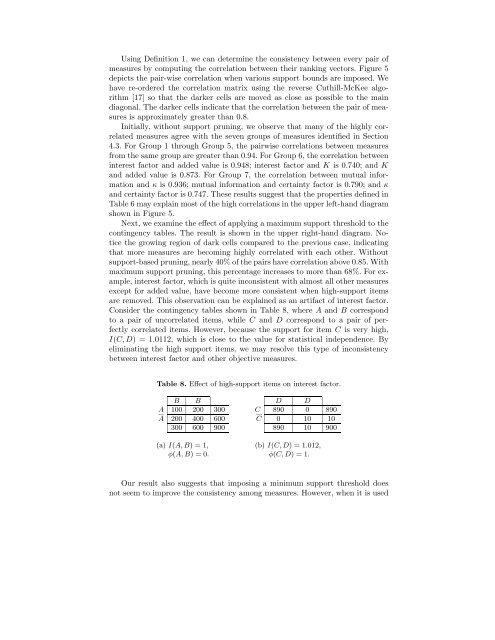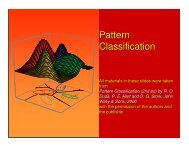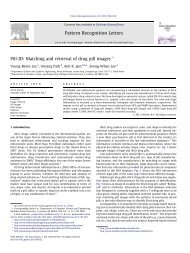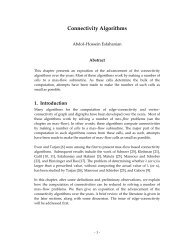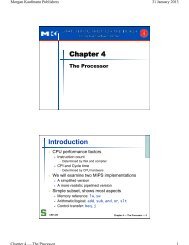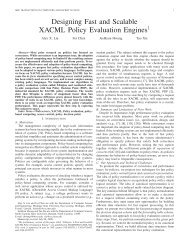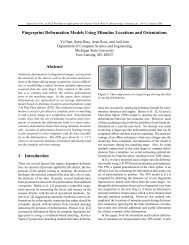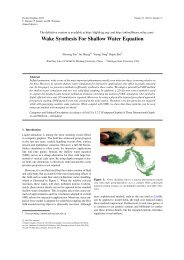Selecting the Right Objective Measure for Association Analysis*
Selecting the Right Objective Measure for Association Analysis*
Selecting the Right Objective Measure for Association Analysis*
Create successful ePaper yourself
Turn your PDF publications into a flip-book with our unique Google optimized e-Paper software.
Using Definition 1, we can determine <strong>the</strong> consistency between every pair of<br />
measures by computing <strong>the</strong> correlation between <strong>the</strong>ir ranking vectors. Figure 5<br />
depicts <strong>the</strong> pair-wise correlation when various support bounds are imposed. We<br />
have re-ordered <strong>the</strong> correlation matrix using <strong>the</strong> reverse Cuthill-McKee algorithm<br />
[17] so that <strong>the</strong> darker cells are moved as close as possible to <strong>the</strong> main<br />
diagonal. The darker cells indicate that <strong>the</strong> correlation between <strong>the</strong> pair of measures<br />
is approximately greater than 0.8.<br />
Initially, without support pruning, we observe that many of <strong>the</strong> highly correlated<br />
measures agree with <strong>the</strong> seven groups of measures identified in Section<br />
4.3. For Group 1 through Group 5, <strong>the</strong> pairwise correlations between measures<br />
from <strong>the</strong> same group are greater than 0.94. For Group 6, <strong>the</strong> correlation between<br />
interest factor and added value is 0.948; interest factor and K is 0.740; and K<br />
and added value is 0.873. For Group 7, <strong>the</strong> correlation between mutual in<strong>for</strong>mation<br />
and κ is 0.936; mutual in<strong>for</strong>mation and certainty factor is 0.790; and κ<br />
and certainty factor is 0.747. These results suggest that <strong>the</strong> properties defined in<br />
Table 6 may explain most of <strong>the</strong> high correlations in <strong>the</strong> upper left-hand diagram<br />
shown in Figure 5.<br />
Next, we examine <strong>the</strong> effect of applying a maximum support threshold to <strong>the</strong><br />
contingency tables. The result is shown in <strong>the</strong> upper right-hand diagram. Notice<br />
<strong>the</strong> growing region of dark cells compared to <strong>the</strong> previous case, indicating<br />
that more measures are becoming highly correlated with each o<strong>the</strong>r. Without<br />
support-based pruning, nearly 40% of <strong>the</strong> pairs have correlation above 0.85. With<br />
maximum support pruning, this percentage increases to more than 68%. For example,<br />
interest factor, which is quite inconsistent with almost all o<strong>the</strong>r measures<br />
except <strong>for</strong> added value, have become more consistent when high-support items<br />
are removed. This observation can be explained as an artifact of interest factor.<br />
Consider <strong>the</strong> contingency tables shown in Table 8, where A and B correspond<br />
to a pair of uncorrelated items, while C and D correspond to a pair of perfectly<br />
correlated items. However, because <strong>the</strong> support <strong>for</strong> item C is very high,<br />
I(C, D) = 1.0112, which is close to <strong>the</strong> value <strong>for</strong> statistical independence. By<br />
eliminating <strong>the</strong> high support items, we may resolve this type of inconsistency<br />
between interest factor and o<strong>the</strong>r objective measures.<br />
Table 8. Effect of high-support items on interest factor.<br />
B B D D<br />
A 100 200 300 C 890 0 890<br />
A 200 400 600 C 0 10 10<br />
300 600 900 890 10 900<br />
(a) I(A, B) = 1, (b) I(C, D) = 1.012,<br />
φ(A, B) = 0. φ(C, D) = 1.<br />
Our result also suggests that imposing a minimum support threshold does<br />
not seem to improve <strong>the</strong> consistency among measures. However, when it is used


